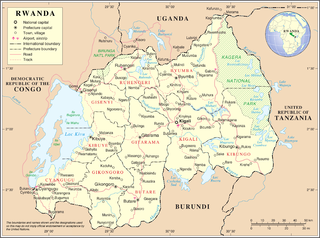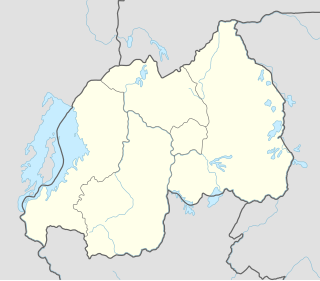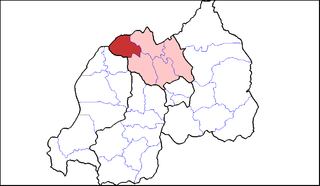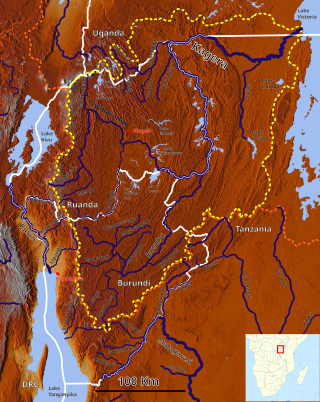
The Great Rift Valley is a series of contiguous geographic trenches, approximately 6,000 kilometres (3,700 mi) in total length, that runs from the Beqaa Valley in Lebanon which is in Asia to Mozambique in Southeast Africa. While the name continues in some usages, it is rarely used in geology as it is considered an imprecise merging of separate though related rift and fault systems.

Rwanda is located in central Africa, to the east of the Democratic Republic of the Congo, at the co-ordinates 2°00′S30°0′E.
This is a list of public holidays in Rwanda. Rwanda observes fourteen regular public holidays.

Volcanoes National Park is a national park in northwestern Rwanda. It covers 160 km2 (62 sq mi) of rainforest and encompasses five of the eight volcanoes in the Virunga Mountains, namely Karisimbi, Bisoke, Muhabura, Gahinga and Sabyinyo. It borders Virunga National Park in the Democratic Republic of Congo and Mgahinga Gorilla National Park in Uganda. It is home to the mountain gorilla and the golden monkey, and was the base for the primatologist Dian Fossey.

Ruhengeri is a city and capital of Musanze District in the Northern Province of Rwanda. Some sources now refer to the city itself as Musanze, after the district in which it lies. This has to do with the adopted policy of renaming Rwanda cities, which was done to eliminate terrible memories of the past and to install new administrational infrastructure in the country. Ruhengeri (Musanze) lies near the twin lakes of Lake Burera and Lake Ruhondo and is the gateway city to Volcanoes National Park and the famous mountain gorillas in the north-western part of the country.

Muhanga is a city in Rwanda, in the Muhanga District, in Southern Province. The city is 5,945 feet (1,812 m) above sea level.

Eastern Province is the largest, the most populous and the least densely populated of Rwanda's five provinces. It was created in early January 2006 as part of a government decentralization program that re-organized the country's local government structures.

Rusumo Falls is a waterfall located on the Kagera river on the border between Rwanda and Tanzania, part of the most distant headwaters of the river Nile. The falls are approximately 15 m (49 ft) high and 40 m (130 ft) wide and have formed on Precambrian schists and quartz–phyllites.
The Banyarwanda are the cultural and linguistic group of people who inhabit mainly Rwanda. Within the Banyarwanda there are three subgroups: Hutu, Tutsi and Batwa. Some Banyarwanda live in the Democratic Republic of the Congo, having migrated there from neighbouring Rwanda in waves. In the Congo, they live in the provinces of North Kivu and South Kivu. There are also 1 million Banyarwanda in Uganda, where they live in the west of the country; Umutara and Kitara are the centres of their pastoral and agricultural areas.

Hilary Bradt MBE is the founder of Bradt Travel Guides, a publisher which became an increasingly visible presence in the travel guide book world starting in the mid-1970s.

Musanze is a district in the Northern Province of Rwanda. Its capital city is Ruhengeri, which is also sometimes known as Musanze.

Presidential elections were held in Rwanda on 9 August 2010, the second since the Rwandan Civil War. Incumbent President Paul Kagame of the Rwandan Patriotic Front (RPF) was re-elected for a second seven-year term with 93% of the vote.

Gahini is a village and sector in Kayonza District, Eastern Province, Rwanda. It is situated on a hill, at an altitude of 1,520 metres (4,990 ft) above sea-level, close to the eastern edge of Lake Muhazi and 73 kilometres (45 mi) by road from the capital, Kigali. The village is the centre of one of the nine dioceses of the Eglise Episcopale au Rwanda, the Anglican church of Rwanda, and one of the four Rwandan sites chosen by the Church Missionary Society, who built a large mission, hospital and schools in the village.

Lake Muhazi is a long thin shallow lake in the east of Rwanda. The bulk of the lake lies in the Eastern Province, with the western end forming the border between the Northern and Kigali Provinces. It is a flooded valley lake, lying predominantly in an east to west direction, but with numerous offshoots in a north to south direction, formerly the location of tributaries. The lake has a concrete dam at the western end, constructed in 1999 to replace an earth dam which had existed since time immemorial. The lake empties into the Nyabugogo River, which flows southwards to Kigali where it meets the Nyabarongo River, part of the upper Nile.

The culture of Rwanda is varied. Unlike many other countries in Africa, Rwanda has been a unified state since precolonial times, populated by the Banyarwanda people who share a single language and cultural heritage. Eleven regular national holidays are observed throughout the year, with others occasionally inserted by the government.

Ndora is a village and commune/sector in Butare Province, south-western Rwanda, located roughly 10 kilometres east of the city of Butare. It is a farming community inhabited mainly by Hutu people. Pauline Nyiramasuhuko was born in Ndora in 1946. Callixte Kalimanzira, head of the Ministry of Interior and Communal Development, met in Ndora on June 7, 1994 and warned the people that the Rwandan Patriotic Front (RPF) were using small children who should also become targets. There is said to be an iron-smelting furnace in Ndora. A number of Hutu women in the village were widowed during the Rwandan genocide.

The Rukarara River is a river in western Rwanda that is a tributary of the Mwogo River, in turn a tributary of the Nyabarongo River. It is the most distant headwater of the Nile.

The Mwogo River is a river in western Rwanda that is a tributary of the Nyabarongo River.

The Congo-Nile Divide region of Rwanda and Burundi is a mountainous area in the southern section of the Congo-Nile Divide, to the east of the Albertine Rift. The region includes the Nyungwe and Kibira national parks. The Bugoyi people live in the region.

Mützig is a beer brand owned by Heineken and its subsidiaries, and was originally brewed in 1810 by Brasserie Mutzig of Alsace, France. It is now a 5.5% ABV lager available in 65cl and 33cl bottles. It has a full-bodied taste and distinctive packaging, and is the most successful premium, locally brewed beer in Central Africa. Mützig is considered a flagship African brand.















